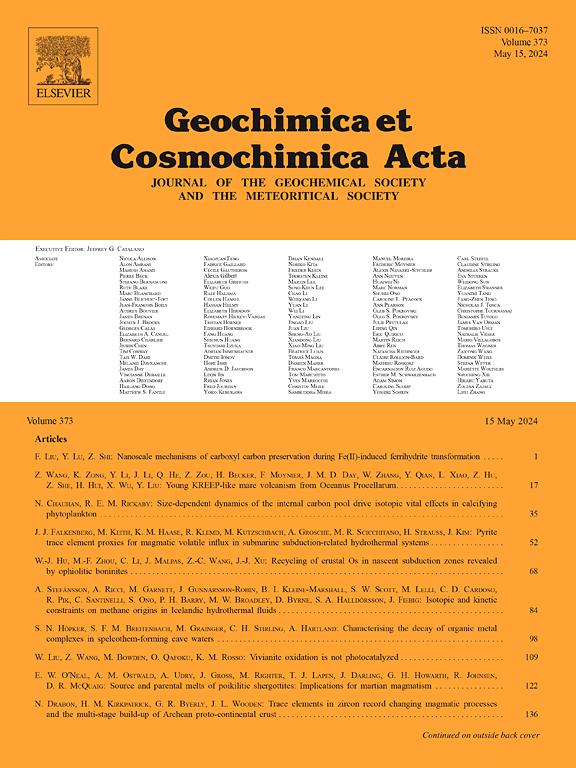Equilibrium Fe isotope fractionation between olivine, pyroxene, spinel and MORB glass: Implications for mantle partial melting to generate MORBs
IF 5
1区 地球科学
Q1 GEOCHEMISTRY & GEOPHYSICS
引用次数: 0
Abstract
Primitive mid-ocean ridge basalts (MORBs) exhibit Fe isotopic compositions heavier than the upper mantle by +0.074 ± 0.028 ‰ for δ56Fe. The processes responsible for this isotopic difference remain unclear. Modeling of Fe isotope fractionation during mantle partial melting requires reliable equilibrium Fe isotope fractionation factors between minerals and melts, for which consistent data are still lacking. In this study, we used Nuclear Resonant Inelastic X-ray Scattering (NRIXS) technique to measure Fe force constants for a MORB glass (ALV 519-4-1) and natural mantle minerals (olivine, orthopyroxene, clinopyroxene, and spinel) to determine the equilibrium Fe isotope fractionation factors between them. The force constants determined in this study, in increasing order, are 167 ± 26 N/m for spinel, 175 ± 17 N/m for olivine, 176 ± 20 N/m for MORB glass, 205 ± 26 N/m for clinopyroxene, and 219 ± 36 N/m for orthopyroxene.
We evaluated the previously proposed mechanisms for the heavy Fe isotopic composition of MORBs, including (i) mantle partial melting, (ii) mantle lithological heterogeneity, with pyroxenite in the source, (iii) mantle metasomatism by low-degree melts, and (iv) fractional crystallization of olivine from melts. For (i), we used the pMELTS program to simulate adiabatic decompression melting of mantle peridotites, and calculated Fe isotope fractionation based on Fe3+–Fe2+ equilibrium-controlled fractionation, where Fe3+ forms stronger bonds and is more incompatible than Fe2+. At 10 wt% peridotite melting, corresponding to MORB generation, only +0.03 ‰ Fe isotope fractionation between the melt and the original bulk composition () was produced, insufficient to account for the observed MORB-upper mantle difference. For (ii), melting of pyroxenites yields smaller Fe isotope fractionation than melting of peridotites, making it unlikely the cause for the MORB-upper mantle isotopic difference. For (iii), both the Fe3+/ΣFe ratio and the δ56Fe of melts increase with the degree of partial melting, indicating that low-degree melts are not isotopically heavy enough to significantly alter the isotopic composition of lithospheric mantle through metasomatism. For (iv), equilibrium isotope fractionation between olivine and melt is near zero. These results suggest that equilibrium Fe isotope fractionation alone cannot explain the MORB isotopic signature, highlighting the potential role of kinetic isotope fractionation. Using a diffusion model, we calculated kinetic Fe and Mg isotope fractionations associated with (iv) olivine crystallization from a melt, and found that the predicted Fe and Mg isotope fractionations were inconsistent with observations in MORBs. Qualitatively, two processes could have induced kinetic Fe isotope fractionation during MORB generation: (a) Fe-Mg interdiffusion between melt and solid during melt migration and (b) reactive melt-rock interactions during melt focusing. However, a quantitative understanding of their role in modifying the melt isotopic composition remains limited and requires further investigation.
橄榄石、辉石、尖晶石和MORB玻璃之间的平衡铁同位素分馏:地幔部分熔融生成MORB的意义
原始洋中脊玄武岩δ56Fe的同位素组成比上地幔重 + 0.074 ± 0.028 ‰。造成这种同位素差异的过程尚不清楚。地幔部分熔融过程中铁同位素分馏的建模需要可靠的矿物和熔体之间的平衡铁同位素分馏因子,而这方面的数据尚缺乏一致性。本研究采用核共振非弹性x射线散射(NRIXS)技术测量了MORB玻璃(ALV 519-4-1)和天然地幔矿物(橄榄石、正辉石、斜辉石、尖晶石)的铁力常数,确定了它们之间的平衡铁同位素分异因子。力常数决定在这项研究中,在增加订单,167 ± 26 N / m为尖晶石,175 ± 17 N / m橄榄石,176年 ±20 N / m MORB玻璃,205 ± 26 N / m斜辉石,和219年 ± 36 N / m斜方辉石类。
本文章由计算机程序翻译,如有差异,请以英文原文为准。
求助全文
约1分钟内获得全文
求助全文
来源期刊

Geochimica et Cosmochimica Acta
地学-地球化学与地球物理
CiteScore
9.60
自引率
14.00%
发文量
437
审稿时长
6 months
期刊介绍:
Geochimica et Cosmochimica Acta publishes research papers in a wide range of subjects in terrestrial geochemistry, meteoritics, and planetary geochemistry. The scope of the journal includes:
1). Physical chemistry of gases, aqueous solutions, glasses, and crystalline solids
2). Igneous and metamorphic petrology
3). Chemical processes in the atmosphere, hydrosphere, biosphere, and lithosphere of the Earth
4). Organic geochemistry
5). Isotope geochemistry
6). Meteoritics and meteorite impacts
7). Lunar science; and
8). Planetary geochemistry.
 求助内容:
求助内容: 应助结果提醒方式:
应助结果提醒方式:


